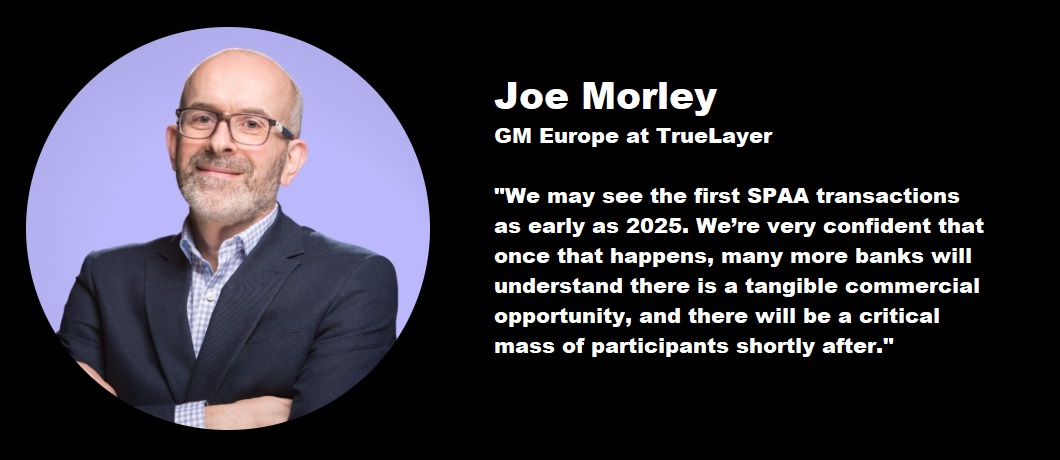
The SEPA Payment Account Access (SPAA) introduces new open banking functionalities, for which banks can charge. Together with the future widespread availability of instant payments in the EU, it can help make A2A payments the main alternative to cards for online payments.
The building blocks of an open, pan-European payment method are in place: SEPA Instant Credit Transfers (SCT Inst) and open banking to turn them into a payment method. The SEPA Payment Account Access (SPAA) scheme is the final piece of the puzzle, enabling a commercial model for open banking and introducing additional features beyond the revised Payment Services Directive (PSD2). The European Payments Council wanted to know more about the first SPAA scheme participant, TrueLayer, so they interviewed EU CEO and General Manager – Joe Morley.
The ‘open banking’ regulated through PSD2 has not been considered a complete success. Could you tell us what you think did and didn’t work well with the open banking regulation?
Open banking in PSD2 has been a net positive: it allowed open-banking providers to come to market at low cost and develop new payment methods and data services. While initially associated more with data services like aggregating account information, the ability to initiate payments has quickly proven to be one of the most impactful applications.
There’s huge demand for alternative payment methods from merchants in particular. Merchants have seen service charges paid to card schemes increase by eight hundred and seventy-six million euros between 2015 and 2020 – and they are still increasing1.
However, it has had a few shortcomings, some of which the EU is addressing through the Payment Services Regulation. For example, the lack of harmonisation and a fragmented implementation of Application Programming Interface (API) standards across providers and Member States.
We also understand that the majority of banks saw open banking purely as a compliance requirement. This has limited the appetite for doing much more beyond that baseline.
How do you think the open banking market will benefit from the SPAA scheme?
Put simply, SPAA introduces financial incentives for banks to participate in open banking and help it grow. We think it will breathe new life into the European open banking ecosystem.
The commercial model will allow banks to monetise APIs and to help develop the next generation of digitally native, account-to-account payment services — all in partnership with fintechs and other payment service providers (PSPs).
SPAA will be a much-needed complement to regulation and will help drive the adoption of instant, open, account-to-account payments.
The SPAA scheme adds a set of premium features and services on top of PSD2 regulatory ones. Which premium services do you think are most interesting for SPAA scheme participants? What about end-users and merchants?
By far the most requested feature by our merchant customers is Dynamic Recurring Payments (DRP), due to the wide range of use cases they can support and the fast growth we’re seeing with its equivalent, Variable Recurring Payments (VRP), in the UK.
With DRP, a customer will be able to set up recurring payments with variable start date, frequency, end date, period, maximum amount per period, and currency.
Through DRP we see exciting new use cases for ecommerce, in particular, such as paying seamlessly for subscriptions or even ‘account-on-file’ functionality that simplifies the checkout process for online purchases and helps drive adoption. The rulebook also includes Personal Finance Management transfers: a version of DRP just for ‘sweeping’ money between your own accounts, which is in high demand in financial services.
Another feature is the Payment Certainty Mechanism, which could be interesting for in-store purchases. It could make it easier to bring one-off open banking payments to point-of-sale (POS) by providing the merchant with an instant guarantee that the funds will be transferred.
What expectations do you have regarding the evolution of the SPAA scheme?
The EU has been searching for a home-grown payment method, but it already has the main ingredients for it: low-cost instant credit transfers (which will soon become widely available) and open banking as a way of bringing them to merchant checkout screens. SPAA brings value by enabling a commercial model for open banking, as well as additional features on top of PSD2, to improve the user experience.
This combination is the most straightforward way to develop an open and sustainable European payment method.
There are already a number of Third Party Providers (TPPs) signed up or preparing to join, most with merchants ready to make use of SPAA payments. So, the demand is there. We expect our colleagues on the asset holder side to begin joining shortly, as the details of the phased rollout being discussed in the Multi-Stakeholder Group begin to materialise.
We may see the first SPAA transactions as early as 2025. We’re very confident that once that happens, many more banks will understand there is a tangible commercial opportunity, and there will be a critical mass of participants shortly after.
The full interview here
____________
Banking 4.0 – „how was the experience for you”
„To be honest I think that Sinaia, your conference, is much better then Davos.”
Many more interesting quotes in the video below: